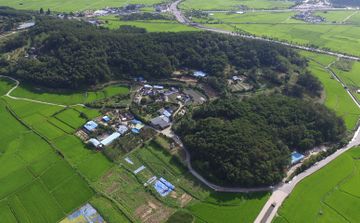경주 낭산 일원
| 경주 낭산 일원 Nangsan Mountain, Gyeongju |
|
 경주 낭산 일원, 국가문화유산포털, 문화재청. |
|
| 대표명칭 | 경주 낭산 일원 |
|---|---|
| 영문명칭 | Nangsan Mountain, Gyeongju |
| 한자 | 慶州 狼山 一圓 |
| 주소 | 경상북도 경주시 보문동 214-2번지 |
| 지정(등록) 종목 | 사적 제163호 |
| 지정(등록)일 | 1968년 12월 13일 |
| 분류 | 유적건조물/유물산포지유적산포지/유적분포지/유적분포지 |
| 시대 | 시대미상 |
| 수량/면적 | 909,854 |
| 웹사이트 | 경주 낭산 일원, 국가문화유산포털, 문화재청. |
|
|
|
해설문
국문
낭산은 신라 왕경인 경주를 사면에서 둘러싸고 있는 토함산(東), 선도산(西), 남산(南), 금강산(北)의 중앙에 위치하고 있어 진산(鎭山)으로 여겨 성역으로 보존해 온 곳이다.
『삼국사기』에 의하면 실성왕 12년(413) 낭산에 구름이 일어나 바라보니 누각(樓閣)과 같았고 향기가 가득 퍼져 오랫동안 없어지지 않으니 왕은 신령이 내려와 노니는 것으로 여기고 복 받은 땅이라고 생각하여 이후로는 그곳에서 나무 베는 일을 금지하고 신성시 하였다고 한다.
7세기부터는 불교의 성스러운 산으로 변하기 시작하였다. 선덕여왕의 유언에 따라 만든 여왕의 능(사적 제182호)을 비롯하여 사천왕사지(사적 제7호)가 있고, 황복사지 삼층석탑(국보 제37호), 낭산 마애보살삼존좌상(보물 제665호) 등 왕실과 불교 관련 유적이 곳곳에 자리하고 있다.
영문
Nangsan Mountain, Gyeongju
Nangsan Mountain has long been preserved as a sacred place as it is considered one of the guardian mountains of the ancient capital of the Silla kingdom (57 BCE-935 CE).
According to the History of the Three Kingdoms (Samguk sagi), the mountain has been considered sacred since the year 413, when clouds in the shape of a pavilion arose above the mountain and stayed there for a long time. This was seen as a sign that the mountain was where the auspicious spirits engaged in merriment. The mountain was thus deemed to be auspicious, and it became forbidden to cut down trees on the mountain.
From the 7th century, the mountain became a sacred place of Buddhism and the Silla royal family. It was at the southern slope of this mountain that Queen Seondeok (r. 632-647) wished to be buried (Historic Site No. 182) and where Sacheonwangsa Temple (Historic Site No. 7) was established in 679. There are also various Buddhist sites on the mountain, including a three-story stone pagoda at Hwangboksa Temple Site (National Treasure No. 37), as well as a rock-carved seated bodhisattva triad (Treasure No. 665).
영문 해설 내용
낭산은 신라 왕경인 경주를 수호하는 명산 중 하나로 여겨져 오랫동안 성역으로 보존되어 왔다.
『삼국사기』에 의하면 413년 낭산에 누각과 같은 구름이 일어나 오랫동안 없어지지 않았으며, 이때부터 이 산이 신성하게 여겨졌다. 이곳은 선령이 내려와 노니는 곳으로 여겨졌고, 복 받은 땅이라고 생각하여 이후로는 이 산의 나무 베는 일이 금지되었다.
7세기부터는 불교와 신라 왕실의 성스러운 산으로 변하기 시작하였다. 불표 중흥을 위해 노력했던 선덕여왕은 낭산 남쪽 기슭에 자신의 능(사적 제182호)을 마련했고, 679년에는 사천왕사(사적 제7호)가 창건되었다. 또한 692년에 만들어진 황복사지 삼층석탑(국보 제37호)과 통일신라시대에 만들어진 마애보살삼존좌상(보물 제665호) 등 불교 관련 유적들도 자리하고 있다.